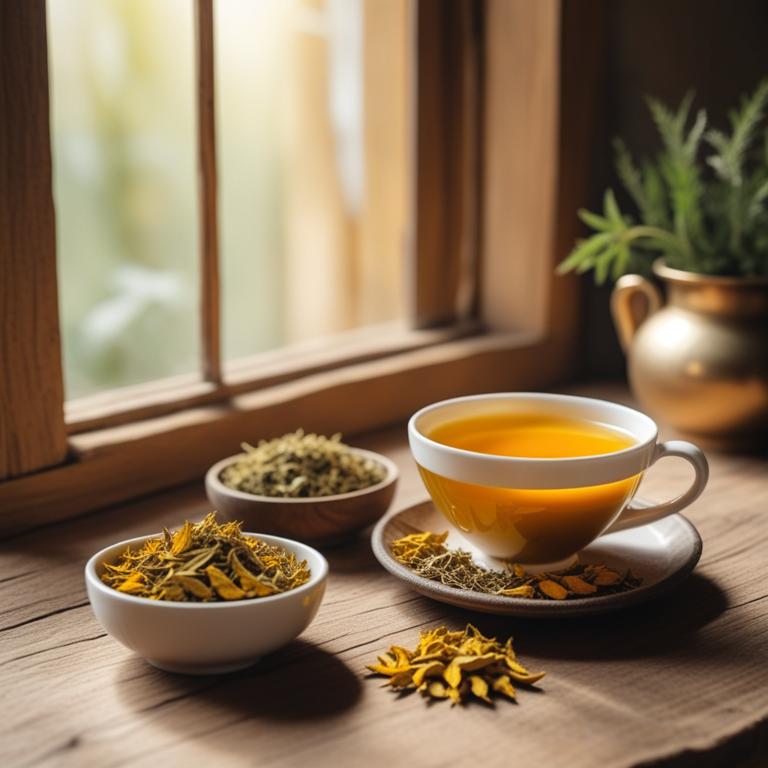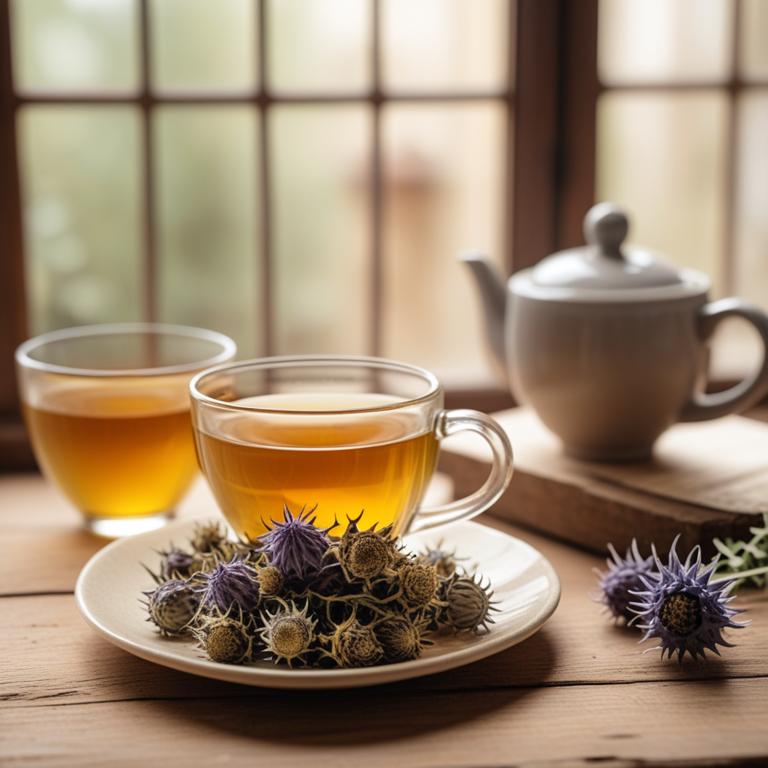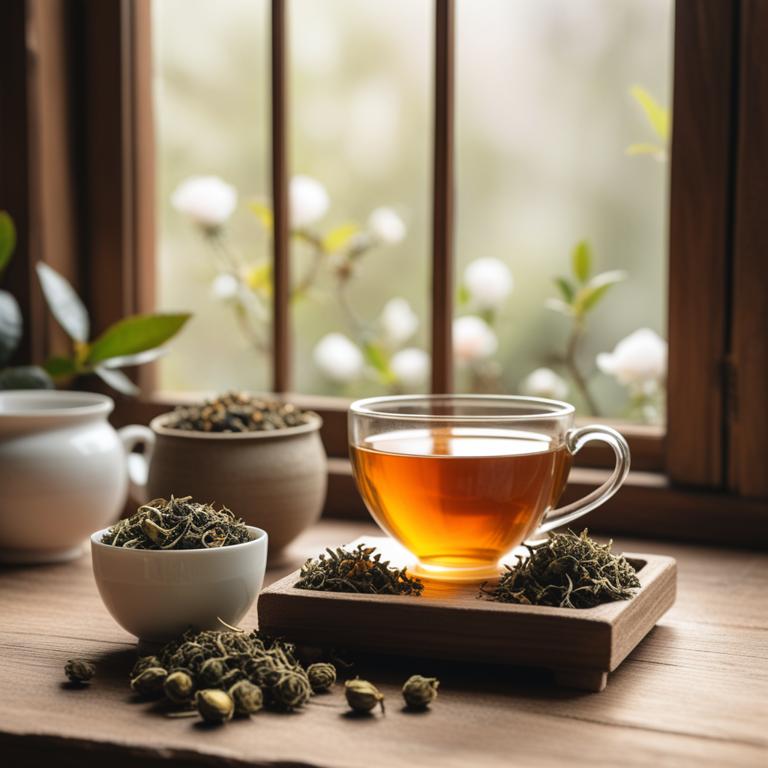9 Herbal Teas For Dark Circles

Herbal teas can be a great way to relieve dark circles under the eyes.
These circles are caused by poor circulation, fatigue, and fluid retention. Certain herbs have properties that help improve circulation, reduce puffiness, and even out skin tone. Ginkgo biloba, for example, is known for its ability to increase blood flow and reduce inflammation. Drinking a cup of ginkgo biloba tea can help improve the appearance of dark circles. Lavandula angustifolia, also known as lavender, has a calming effect on the body. When you're tired, your body tends to hold onto fluids, leading to puffiness and dark circles.
Lavender tea can help calm your body, reducing fluid retention and promoting better sleep. This can, in turn, reduce the appearance of dark circles. Rosmarinus officinalis, or rosemary, is another herb that can help relieve dark circles. It's a natural stimulant that can improve circulation and reduce inflammation. Drinking rosemary tea can help increase oxygen flow to the skin, reducing the appearance of dark circles and leaving your skin looking more even-toned. Drinking herbal teas for dark circles can bring several benefits to your life. Improved circulation can give you more energy, while better sleep can improve your mood and overall well-being.
By reducing inflammation and fluid retention, you can also reduce the appearance of fine lines and wrinkles, leaving your skin looking smoother and more radiant.
- 1. Ginkgo biloba
- 2. Lavandula angustifolia
- 3. Rosmarinus officinalis
- 4. Zingiber officinale
- 5. Echinacea purpurea
- 6. Silybum marianum
- 7. Melissa officinalis
- 8. Camellia sinensis
- 9. Curcuma longa
1. Ginkgo biloba

Ginkgo biloba teas contains flavonoids, terpenoids, and bilobalide, which are active constituents that help reduce dark circles under the eyes.
Flavonoids, particularly quercetin and kaempferol, have anti-inflammatory properties that decrease swelling and puffiness around the eyes. Terpenoids, such as ginkgolides, improve blood circulation and reduce fluid accumulation, which can contribute to dark circles. Bilobalide has antioxidant properties that help protect the skin from damage caused by free radicals, which can lead to discoloration.
By reducing inflammation, improving circulation, and protecting the skin, Ginkgo biloba teas can help minimize the appearance of dark circles.
- Gather 1 tablespoon of dried Ginkgo biloba leaves and 1 cup of boiling water.
- Steep the Ginkgo biloba leaves in the boiling water for 5-7 minutes.
- Strain the mixture into a cup using a fine-mesh sieve or cheesecloth.
- Add 1 tablespoon of honey (optional) to the tea and stir well.
- Drink the tea once a day, preferably before bed, to help reduce dark circles.
2. Lavandula angustifolia

Lavandula angustifolia teas contains linalool, linalyl acetate, and camphor, which are the main bioactive constituents.
These compounds have anti-inflammatory and antioxidant properties, which help to reduce puffiness and discoloration around the eyes. The calming and soothing effects of linalool also help to relax the muscles and improve blood flow, reducing the appearance of dark circles. Additionally, the antioxidant properties of linalyl acetate help to protect the skin from free radical damage, which can contribute to the formation of dark circles.
Drinking Lavandula angustifolia teas may help to reduce the appearance of dark circles by improving circulation and reducing inflammation around the eyes.
- Gather 1 cup of fresh Lavandula angustifolia flowers or 2 teaspoons of dried flowers.
- Heat 1 cup of water in a pot until it boils.
- Add the Lavandula angustifolia flowers to the boiling water and let it steep for 5-7 minutes.
- Strain the tea into a cup and discard the flowers.
- Let the tea cool, then apply it to the affected area using a cotton pad or cloth for 10-15 minutes before rinsing off.
3. Rosmarinus officinalis

Rosmarinus officinalis teas contains essential oils like rosmarinic acid, carnosic acid, and borneol.
These compounds have anti-inflammatory and antioxidant properties, which help reduce puffiness and darkening of the skin under the eyes. The rosmarinic acid in particular has been shown to inhibit the production of melanin, a pigment that contributes to dark circles. Additionally, the antioxidants in Rosmarinus officinalis teas help protect the delicate skin under the eyes from damage caused by free radicals, which can exacerbate dark circles.
By reducing inflammation and protecting the skin, Rosmarinus officinalis teas can help minimize the appearance of dark circles.
- Gather 1 cup of boiling water, 1 tablespoon of dried Rosmarinus officinalis leaves, and a tea infuser.
- Measure 1 tablespoon of dried Rosmarinus officinalis leaves and place them in the tea infuser.
- Steep the herbs in the boiling water for 5-7 minutes, then let it cool.
- Strain the tea and discard the herbs. You can add honey or lemon to taste, if desired.
- Soak two cotton pads in the cooled tea and place them under your eyes for 10-15 minutes to help reduce dark circles.
4. Zingiber officinale

Zingiber officinale teas contains active constituents like gingerols and shogaols.
These compounds have anti-inflammatory properties that help reduce puffiness around the eyes. The antioxidants and flavonoids present in the tea have a soothing effect on the skin, reducing dark circles caused by poor circulation and fluid retention. Ginger's ability to improve blood flow and reduce inflammation also helps to reduce the appearance of dark circles.
Regular consumption of Zingiber officinale teas may help to brighten and even out skin tone.
- Gather 1 tablespoon of dried Zingiber officinale (ginger) root and 1 cup of boiling water.
- Steep the ginger root in the boiling water for 5-7 minutes.
- Strain the mixture into a cup using a fine-mesh sieve or cheesecloth.
- Add 1 tablespoon of honey to the ginger tea and mix well.
- Drink the ginger tea 2-3 times a day to help reduce dark circles under the eyes.
Zingiber Officinale Tea on Amazon
FGO Organic Ginger Tea, 100 Count, Eco-Conscious Tea Bags, Caffeine Free, Packaging May Vary (Pack of 1)
Disclaimer: We earn a commission if you click this link and make a purchase at no additional cost to you.
5. Echinacea purpurea

Echinacea purpurea teas contains alkylamides and caffeic acid, which are key bioactive constituents that help reduce dark circles.
Alkylamides have potent antioxidant properties, neutralizing free radicals that cause oxidative stress and contribute to dark circle formation. Caffeic acid, on the other hand, has anti-inflammatory properties that help reduce puffiness and swelling around the eyes. The flavonoids present in Echinacea purpurea teas, such as quercetin and kaempferol, also have a soothing effect on blood vessels, which can help reduce the appearance of dark circles.
By reducing inflammation and oxidative stress, Echinacea purpurea teas helps to give the appearance of brighter, more radiant eyes.
- Gather 2 tablespoons of dried Echinacea purpurea flowers and 1 cup of boiling water.
- Steep the flowers in boiling water for 5-7 minutes.
- Strain the liquid into a cup, discarding the flowers.
- Add 1 tablespoon of honey to sweeten the tea, if desired.
- Drink the tea once or twice a day to help reduce dark circles under the eyes.
6. Silybum marianum

Silybum marianum teas contains silymarin, a mixture of flavonoids and polyphenols, which are powerful antioxidants that help reduce inflammation and protect the skin.
These antioxidants also have anti-angiogenic properties, which can help slow down the growth of new blood vessels under the eyes, a common cause of dark circles. Silymarin also has anti-inflammatory properties, which can help reduce puffiness and swelling in the area. Furthermore, silymarin has been shown to improve the overall health of the skin, increasing its elasticity and firmness, and reducing the appearance of dark circles.
The flavonoids and polyphenols in silymarin work together to improve blood flow and reduce the visibility of dark circles under the eyes.
- Gather 1 teaspoon of dried Silybum marianum flowers and 1 cup of boiling water.
- Steep the Silybum marianum flowers in the boiling water for 5-7 minutes.
- Strain the mixture through a fine-mesh sieve into a cup.
- Add 1 tablespoon of honey (optional) to the tea and mix well.
- Drink the tea once a day to help reduce dark circles.
7. Melissa officinalis

Melissa officinalis teas contains rosmarinic acid, a powerful antioxidant that helps reduce inflammation and puffiness under the eyes.
This compound also has a vasoconstrictive effect, which means it can narrow blood vessels and reduce blood flow to the area, helping to minimize the appearance of dark circles. Additionally, the tea contains flavonoids, such as kaempferol and quercetin, which have anti-inflammatory properties that can help soothe and calm the skin around the eyes. The diuretic properties of Melissa officinalis can also help reduce water retention, which is a common contributor to dark circles.
By reducing inflammation, constricting blood vessels, and minimizing water retention, Melissa officinalis teas can help reduce the appearance of dark circles under the eyes.
- Gather 1 tablespoon of dried Melissa officinalis leaves and 1 cup of boiling water.
- Steep the Melissa officinalis leaves in the boiling water for 5-7 minutes.
- Strain the mixture into a cup to remove the leaves.
- Let the tea cool down to room temperature.
- Soak a cotton pad in the cooled tea and apply it to the dark circles for 10-15 minutes.
8. Camellia sinensis

Camellia sinensis teas contains antioxidants like theaflavins and thearubigins, which help to reduce the appearance of dark circles by fighting free radicals that cause damage to skin cells.
The flavonoids present in Camellia sinensis teas, such as quercetin and kaempferol, also have anti-inflammatory properties that can help to reduce puffiness and swelling around the eyes. Additionally, the caffeine in Camellia sinensis teas can help to constrict blood vessels and improve circulation, which can help to reduce the discoloration and visibility of dark circles. The polyphenols in Camellia sinensis teas can also help to protect the skin from environmental stressors and promote healthy collagen production, which can help to improve the appearance of dark circles.
By reducing inflammation, improving circulation, and protecting the skin, Camellia sinensis teas can help to make dark circles appear less noticeable.
- Gather 1 cup of Camellia sinensis leaves (black tea) and 1 cup of boiling water.
- Steep the tea leaves in the boiling water for 3-5 minutes. Strain the leaves and let the tea cool.
- Soak 2 tea bags of green tea (Camellia sinensis) in 1 cup of cold water for 5 minutes.
- Combine the cooled black tea and green tea. Add 1 tablespoon of honey and 1 tablespoon of aloe vera gel.
- Apply the mixture to the dark circles and let it sit for 10-15 minutes before rinsing with cold water.
9. Curcuma longa

Curcuma longa teas contains bioactive constituents like curcumin, demethoxycurcumin, and bisdemethoxycurcumin.
These compounds have anti-inflammatory and antioxidant properties that help reduce puffiness and discoloration around the eyes. Curcumin, in particular, has potent antioxidant properties that neutralize free radicals, which can cause dark circles. The anti-inflammatory properties of curcuma longa also help reduce fluid retention and swelling, making it easier to get rid of dark circles.
Regular consumption of curcuma longa tea may help improve blood circulation and reduce the appearance of dark circles.
- Boil 1 cup of water in a kettle or on the stove.
- Measure 1 teaspoon of dried Curcuma longa root and add it to a tea infuser.
- Pour the boiling water over the Curcuma longa root in the infuser.
- Let it steep for 5-7 minutes, then remove the infuser from the cup.
- Strain the tea into another cup and drink it warm, 2-3 times a week.